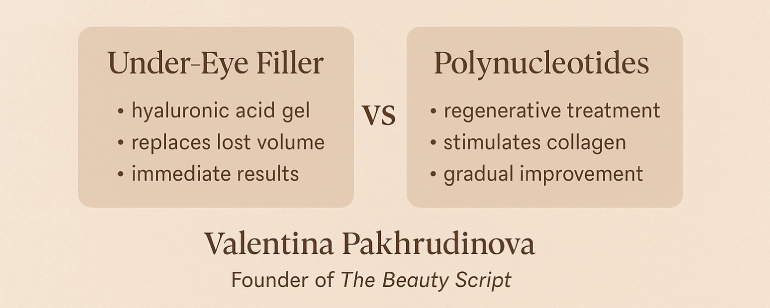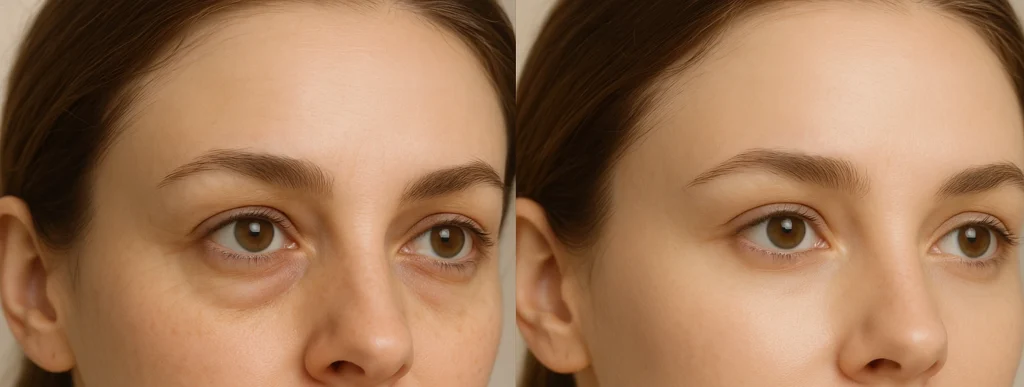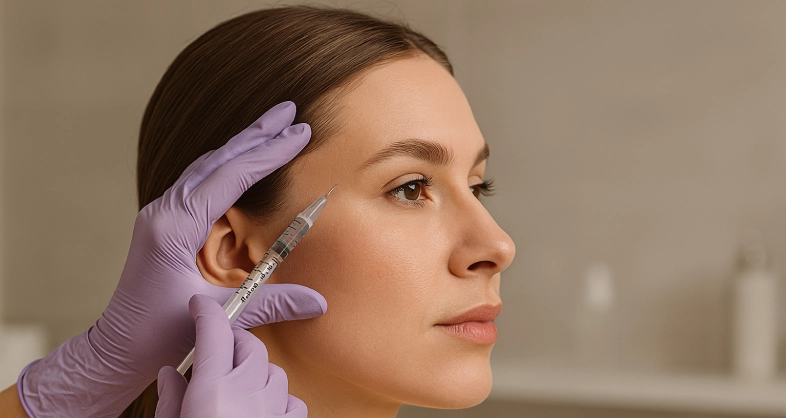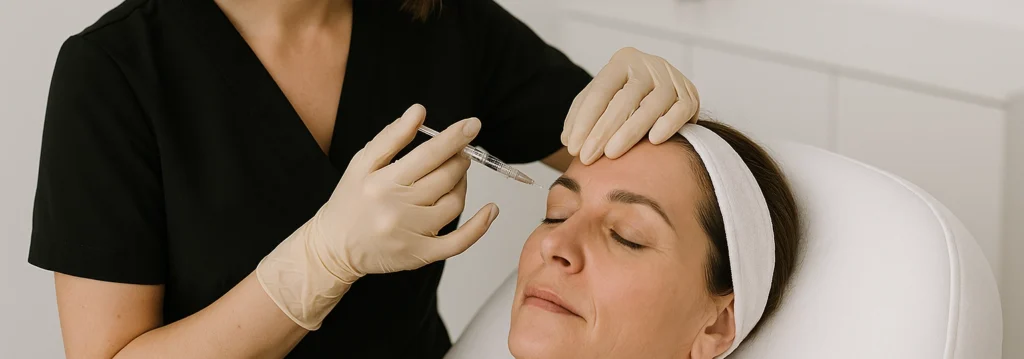“I’m tired of my tired eyes” is one of the most common concerns I hear in the clinic. It’s that unmistakable look when no amount of sleep, concealer, or eye cream seems to help.
The under-eye area is delicate, and even subtle changes can make you appear more exhausted than you actually feel.
The good news? Modern aesthetic medicine offers highly effective treatments to restore brightness and freshness. Two of the most popular options in London are under-eye filler and polynucleotides. Both are excellent but work in very different ways.
What is tear trough filler?
Under eye filler, also known as tear trough filler, is a hyaluronic acid gel. The same molecule naturally found in our bodies that binds water and keeps skin plump.
When carefully placed beneath the eyes, it acts like a structural support, replacing lost volume in hollow areas and softening shadows. By slightly masking the underlying blood vessels, it also helps reduce the bluish undertone that often contributes to looking tired.
At The Beauty Script we predominantly use Teoxane Redensity 2 and Juvederm Volbella for this delicate area. These are light, smooth fillers designed to integrate seamlessly with the tissue, avoiding puffiness or an artificial look.
Patients looking for under eye filler in London often find these to be the safest and most natural-looking options.
What are polynucleotides?
Polynucleotides may look similar to filler in a syringe, but their role is completely different. They are regenerative injectables made from purified DNA fragments that stimulate your own skin to work harder.
By encouraging collagen and elastin production, improving circulation, and strengthening fragile tissue, they gradually restore healthier, thicker skin with improved texture and fewer fine lines.
While fillers physically replace volume, polynucleotides under the eyes rejuvenate the skin itself. They are particularly effective for reducing pigmentation under the eyes (though not the vascular kind), helping to brighten dark circles naturally.
We use Plinest, one of the most trusted and licensed polynucleotide brands in the UK. A typical treatment plan begins with three sessions spaced a few weeks apart, with results building gradually and maintenance sessions recommended once or twice a year.

How do they compare?
Longevity
Tear trough filler usually lasts around 12 months and rarely requires top-ups within that time.
Polynucleotides, on the other hand, need an initial course of three sessions, followed by occasional maintenance.
Results
Filler provides an instant lift by physically restoring lost volume. Polynucleotides deliver gradual improvements as the skin repairs and regenerates, with results unfolding over weeks and months.
Who they suit
Filler works best for true hollows where there is visible volume loss. Polynucleotides are ideal when the concern is crepey skin, pigmentation, or early signs of ageing.

Who is the ideal candidate?
Filler
Best for patients with significant hollowing or depletion under the eyes. If the area looks sunken and shadowed, filler often gives the most immediate and noticeable improvement.
Polynucleotides
Best for patients with fragile, tired-looking, or uneven skin but minimal hollowing. They are also a great option for those with fluid retention or poor lymphatic drainage, as fillers can sometimes worsen puffiness, while polynucleotides improve the skin without adding bulk.
Who should avoid filler?
If you wake up puffy, retain fluid easily, or have extremely thin skin without a true hollow, filler may not be the right option. Hyaluronic acid is hydrophilic, meaning it attracts water, which can increase swelling under the eyes.
Equally, if mid-face support is lacking (for example, a flat cheek area), placing filler directly under the eye can migrate into areas of less resistance. Think of it like building a house without laying the foundation first — it won’t last.
And of course, if filler doesn’t align with your personal values, there are plenty of alternative approaches.
At The Beauty Script, we respect those preferences and will always tailor your treatment plan accordingly.
Can you combine the two?
Yes — and often with beautiful results. For some patients, we start with polynucleotides to repair and thicken the skin before adding filler to restore lost structure. For others, filler comes first, followed by polynucleotides to enhance skin quality.
The right plan depends entirely on your anatomy and goals.
Final Thoughts
Both treatments are powerful tools, but they are not interchangeable. Think of filler as laying the foundation — rebuilding lost structure. Polynucleotides, on the other hand, improve the quality of the “soil” — strengthening and rejuvenating the skin itself.
At The Beauty Script, we believe there is no one-size-fits-all solution. Every face tells its own story, and our role is to guide you towards the treatment or combination that will help you look refreshed, balanced, and authentically yourself.
Fresh eyes aren’t about trends — they’re about restoring harmony so that you look like you, just brighter and better rested.
Valentina Pakhrudinova, Founder of The Beauty Script


